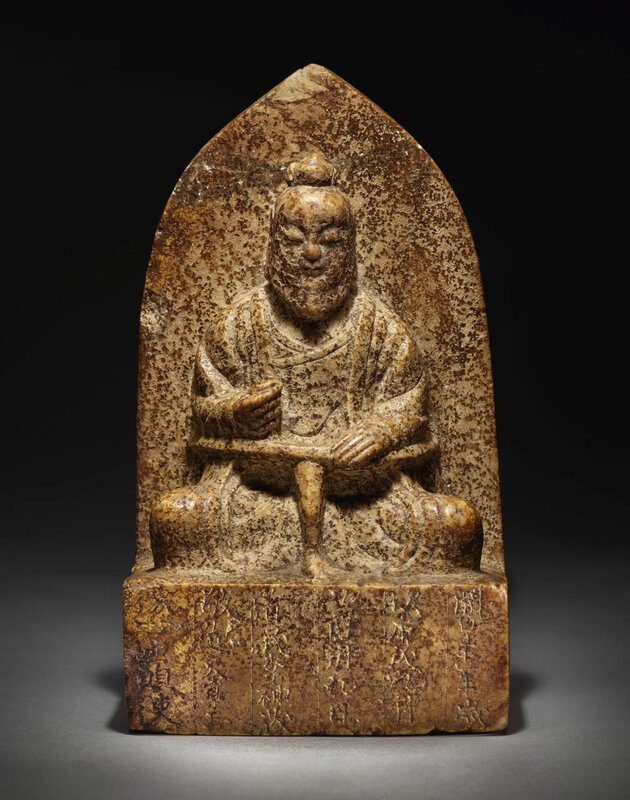An inscribed huanghuashi stele of a Daoist figure, Sui dynasty, dated 10th year of the kaihuang period, corresponding to 590
Lot 138. An inscribed huanghuashi stele of a Daoist figure, Sui dynasty, dated 10th year of the kaihuang period, corresponding to 590. Height 7 3/8 in., 18.7 cm. Estimate 80,000 — 120,000 USD. Courtesy Sotheby's.
carved seated cross-legged with a tripod armrest encircling the front half of the torso, wearing a small scholar's cap, the face with a pointed beard and eyes closed in meditation, the stocky body clothed in an interior garment crossed over the chest, with an outer robe open and hanging in creased folds, the hands atop the armrest and the proper right hand holding a small vessel, all supported on a rectangular base, inscribed to the front and one side, dated tenth year of the Kaihuang period, corresponding to 590.
Provenance: Tonying & Company, Inc, New York, 15th February 1946.
Collection of Stephen Junkunc, III (d. 1978).
Note: This stele appears to depict Daode Tianzhu (Celestial Worthy of the Way and Its Virtue), more commonly known as Laozi, recognizable by the full beard, distinctive hat and three-legged armrest. Stone stele from this period depicting Daoist deities are of great historical importance as they demonstrate the fluid boundary and syncretism between Daoism and Buddhism when their belief systems were first formalized. The form of the stele with its flame-shaped mandorla, the representation of the Doaist deity in the meditative lotus position, and the format of the dedicatory inscription on the rectangular platform are characteristics also found on contemporaneous Buddhist stele. Furthermore, the round modeling of the figure’s body and the carefully incised lines to depict the robe, suggest a dialogue between carvers of Daoist and Buddhist icons.
The collapse of the Han dynasty had a great impact on the development of Daoism, as it turned from a philosophical current into a religion with a specific set of beliefs and practices. The transformation is attributed in part to the spiritual leader Zhang Daoling, who lived during the Eastern Han dynasty, and claimed to have had a revelation of the deified Laozi who ordered him to organize his devotees into a movement, which later came to be known as the Tianshi Dao (The Way of the Celestial Masters). While the first mention of Laozi is found in the Shiji (Records of Historians) by Sima Qian (145-86 BC), depictions of the deity in sculptural form did not appear until the 2nd and 3rd century AD, concurrent to the appearance of the earliest Buddhist images. It is also in this period that Laozi began to be thought of as the central deity of the cosmos.
A stone stele of Laozi inscribed with a cyclical date corresponding to 588, was included in the exhibition Chinese Buddhist Stone Sculpture. Veneration of the Sublime, Osaka Municipal Museum, Osaka, 1995, cat. no. 131; one dated to 587, also featuring two attendants standing on lions, in the Museum of Fine Arts, Boston, was included in the exhibition Taoism and the Arts of China, The Art Institute of Chicago, Chicago, 2000, cat. no. 32, together with a Tang dynasty example in the Field Museum, Chicago, cat. no. 42; a Northern Zhou stele dated by inscription to 566, also carved with the deity and two attendants in the collection of the Tokyo University, is illustrated in Rokuchô no Bijutsu [The Arts of the Six Dynasties], Osaka, 1976, pl. 255; another in the Museum of Fine Arts, Boston, is published on the Museum’s website, acc. no. 07.741; and a further example dated by inscription to the 29th year of Kaiyuan, corresponding to 741, in the collection of the Ruicheng Museum, was included in the exhibition Ancient Taoist Art from Shanxi Province, University Museum and Art Gallery, The University of Hong Kong, Hong Kong, 2003, cat. no. 79.
Sotheby's. Junkunc: Arts of Ancient China, New York, 19 march 2019, 10:00 AM

/https%3A%2F%2Fprofilepics.canalblog.com%2Fprofilepics%2F1%2F0%2F100183.jpg)
/https%3A%2F%2Fstorage.canalblog.com%2F03%2F02%2F119589%2F96711876_o.jpg)
/https%3A%2F%2Fstorage.canalblog.com%2F11%2F31%2F119589%2F94773502_o.jpg)
/https%3A%2F%2Fstorage.canalblog.com%2F20%2F83%2F119589%2F94772815_o.jpg)
/https%3A%2F%2Fstorage.canalblog.com%2F26%2F72%2F119589%2F75604929_o.jpg)
/https%3A%2F%2Fstorage.canalblog.com%2F59%2F60%2F119589%2F26458628_o.jpg)





/http%3A%2F%2Fstorage.canalblog.com%2F54%2F03%2F119589%2F126618278_o.jpg)
/http%3A%2F%2Fstorage.canalblog.com%2F23%2F20%2F119589%2F126357156_o.jpg)
/http%3A%2F%2Fstorage.canalblog.com%2F09%2F74%2F119589%2F112768481_o.jpg)
/http%3A%2F%2Fstorage.canalblog.com%2F69%2F60%2F119589%2F112694898_o.jpg)